It may not be a well-known existence, but in this article, we will introduce the "digital potentiometer".
First of all, what is a potentiometer?
A potentiometer originally referred to a device that converts resistance values, which change depending on the rotation angle or linear position, into voltage (current), but variable resistors (volumes) and semi-fixed resistors (trimmers) that adjust analog voltage or current are also used in the potentiometer category.
Structurally, it consists of a resistor and a contact that slides over the resistor.
Digital volume?
Potentiometers have sliding parts in their structure, so if they are subjected to vibration or shock, the position of the contacts may change and the output may fluctuate. In addition, over time, the contacts may become loose and the output may not be normal. When you turn the volume on an old radio, you often hear a "grrr" sound. This is caused by a loose contact.
Digital potentiometers have a longer lifespan as a component because they have no mechanical moving parts, and because they have no sliding parts, they are free from problems caused by poor contact. So how are digital potentiometers used?
Digital Potentiometer Operation
Even though it's digital, the functionality is the same as a traditional potentiometer.
Common applications in electrical and electronic circuits include voltage regulation, current regulation and gain regulation.
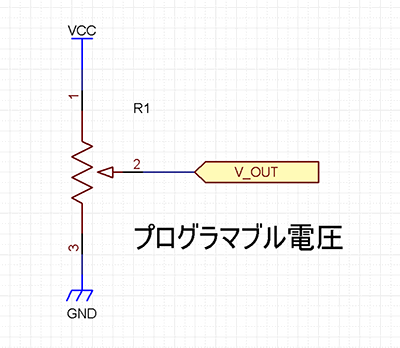
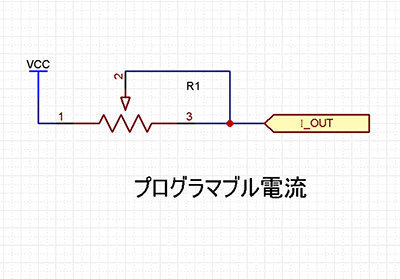
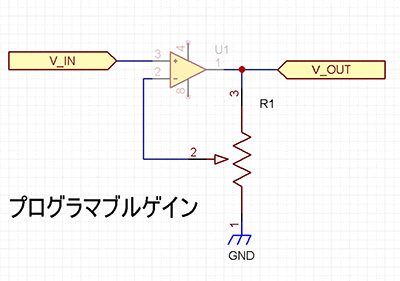
Digital potentiometer architecture
Digital potentiometers are also three-terminal devices that consist of a series-connected resistor string and a switch.
The wiper terminal position can be set by a digital code, allowing connection to any location on the resistor string.
The resistance between 1 and 3 is called the end-to-end resistance.
The sum of the resistance between 1-2 and the resistance between 3-2 is the resistance value between 1-3.
There are no particular restrictions on the polarity of the voltage applied to terminals 1, 2, and 3.
However, do not apply signals that exceed the power supply voltage range.
Digital potentiometer interface
Now, how do we change the resistance value of the digital potentiometer?
There are various interfaces available for setting resistance values.
In addition to commonly used serial interfaces such as I2C and SPI, there are also push button interfaces that increase or decrease the resistance value using up and down buttons, and up-down interfaces that increase or decrease the resistance value using the Hi/Lo level of a signal.
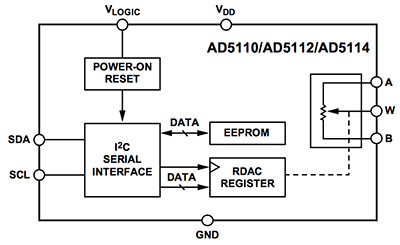
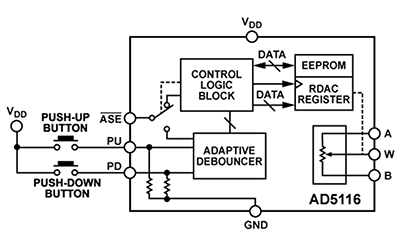
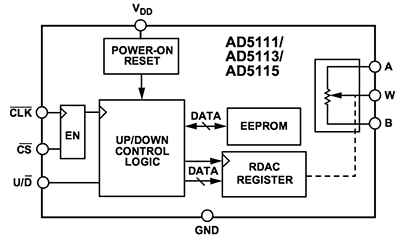
Internal memory of the digital potentiometer
Now, I hope you have understood the general operation of a digital potentiometer. From here, I will explain the points to note when using it.
First of all, about the set resistance value, the position of the mechanical potentiometer and volume is retained even if the power is turned off, right?
However, since the digital potentiometer sets the resistance value electrically, the resistance value is reset when the power is turned off.
Therefore, for applications where you want to maintain the set resistance value even when the power is turned off, a built-in memory is used to memorize (record) the resistance value.
The following types of digital potentiometers are available depending on the usage and purpose.
| Types of memory for setting resistance values | Potentiometer resistance value setting operation by memory type |
| Volatile memory | The set resistance value is reset when the power is turned off. Typically midscale at power up. |
| One-time programmable | Wiper power-up position can be set only once. Ideal for factory calibration. |
| Multi-time programmable | Equipped with a memory that guarantees the retention of wiper settings for several tens of times. |
| EEPROM | Some models are guaranteed to last up to 100k writes and rewrites and to retain data for 50 years. |
Please select the interface and memory configuration depending on your intended use.
The digital potentiometer is also available here, so please try using it once.
Also, if you want to make a potentiometer model with LTspice, please see here.
Inquiry
If you have any questions regarding this article, please contact us below.
Analog Devices Manufacturer Information Top
If you want to go back to Analog Devices Manufacturer Information Top, please click below.
